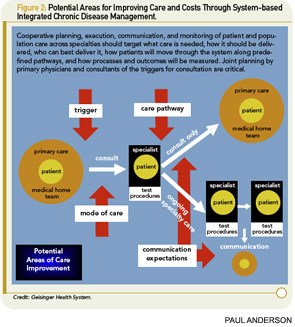Proven change management methods also mandate that any proposal as far reaching as the Medical Home should first be tested and refined in clinical improvement pilot projects, and nationally implemented only when, or if, proven. More specifically, we believe that the existing Medical Home pilots should be given sufficient time and resources to determine key process redesigns, resource costs, and the reliability of their evidence-based chronic disease management. Accepting incremental improvements rather than solutions as a basis for change is equally risky.
The Medical Home model could have unintended adverse consequences for primary and specialty physicians. Healthcare redesigns must save physicians time, reduce work, improve patient care, and create equitable and sustainable compensation. The work and costs of managing change must also be considered and compensated. It is not clear that the Medical Home will fulfill these expectations or improve the professional experience of the primary care physician without careful and thoughtful change management and dramatic changes in physician payment mechanisms. Improving primary care compensation without addressing the same problems that plague subspecialists involved in managing chronic diseases is, at best, inequitable. We cannot afford to have a competitive wedge driven between primary care internists and family physicians on one hand and specialty internists on the other. Furthermore, it is not clear that patients with chronic diseases will buy into the Medical Home model either, especially if they sense that their treating specialists are not supporting it, or if their expectations for care are not maintained.
The unintended negative impact of electronic medical records (EMRs) on primary physicians’ workloads is one example of what might compromise implementing the Medical Home in individual practices and local health systems before the concept is tested, refined, and validated. EMR implementation is often launched with insufficient thought to the requirements for practice standardization, consensus and tool building, and changes in workflow. This leads to a physician-centric EMR work model, which is inherently inefficient. As another example of the unintended consequences of premature implementation, the expectation that primary care in the UWMF health system could absorb the coordination of chronic disease care has proven to be unfounded; improved outcomes have not been documented across the spectrum of chronic diseases, and problems with referral management continue as before (JTH personal observations). The prospect of degrading rather than enhancing successful collaborations between primary and subspecialty physicians has also been demonstrated.24
Successes in pediatrics may not translate to adult medicine. In pediatrics, where the Medical Home was first implemented, the mix of preventive, acute disease, and chronic disease service requirements is very different than for adult medicine, as is the mix and distribution of primary care and specialist manpower. These realities make the Medical Home realistic for pediatric care, but they have not obviated the need for more effective management of referrals from primary care to scarce and often remote subspecialists.26 The greater demands for chronic disease management in adults and the different mix of primary physicians and specialists suggest that the pediatric model might not be suitable for adult medicine.

System-based Chronic Disease Management Model
System-based management for chronic diseases organizes patient and disease population care across specialties and over time at the health system level, rather than through any one specialty. This type of model depends on building consensus among all involved providers as to what care is optimal and how it will be organized. Its foundations are evidence-based guidelines and business and resource planning. It relies on disease registries, nurse coordination of care, robust information technology, structured measures of care processes and disease outcomes, and continuous quality improvement. It shifts the emphasis of physician office visits from routine coordination of care that is performed more reliably off-line by others to clinical problem solving for which the physician is uniquely trained. The evolution of programs that meet this definition has been driven by the failures of less structured approaches to achieve effective care productive of excellent, sustainable outcomes. Programs of system-based management have generally evolved in more highly integrated health systems where financial incentives are well aligned, and physician compensation is structured to encourage cooperation.13,27


